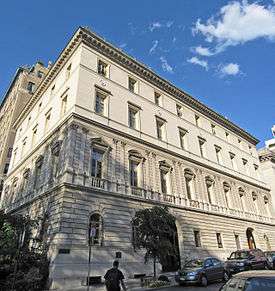Otto Hermann Kahn
| Otto Hermann Kahn | |
|---|---|
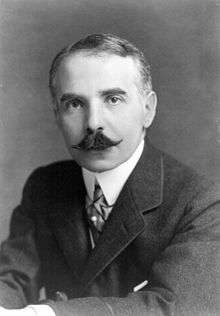 | |
| Born |
February 21, 1867 Mannheim, Germany |
| Died |
March 29, 1934 (aged 67) New York City, United States |
| Occupation | Banker |
| Employer | Kuhn, Loeb & Co. |
| Spouse(s) | Addie Wolff |
| Signature | |
 | |
Otto Hermann Kahn (February 21, 1867 – March 29, 1934) was a German-born investment banker, collector, philanthropist, and patron of the arts.
Life and career

Otto was born on February 21, 1867 in Mannheim, Germany, and raised there, by his Jewish parents, Emma (née Eberstadt) and Bernard Kahn.[1] His father had been among the refugees to the United States after the revolution of 1848 and had become an American citizen, but later returned to Germany. Kahn was educated in a gymnasium in Mannheim.[2]
Kahn's ambition was to be a musician, and he learned to play several instruments before he graduated from the gymnasium, but he was one of eight children, and his father had set plans for the career of each one. Kahn he destined to be a banker. At 17, Kahn was placed in a bank at Karlsruhe as a junior clerk, where he remained for three years, advancing until he was thoroughly grounded in the intricacies of finance. He then served for a year in the Kaiser's hussars.[2][3]
On leaving the army he went to the London agency of Deutsche Bank, where he remained five years. He displayed such unusual talents that he became second in command when he had been there but a comparatively short time. The English mode of life, both political and social, appealed to him, and eventually he became a naturalized British subject.[3]
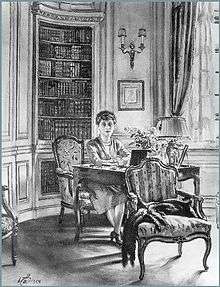
In 1893, he accepted an offer from Speyer and Company of New York and went to the United States, where he spent the rest of his life. On January 8, 1896, Kahn married Addie Wolff and following the couple's year-long tour of Europe, Kahn joined Kuhn, Loeb & Co. in New York City, where his father-in-law, Abraham Wolff, was a partner. In 1917, Kahn gave up his British nationality and became a United States citizen.[4]
Besides his father-in-law, Kahn's other partners included Jacob Schiff, himself the son-in-law of Solomon Loeb, who co-founded the firm, and Paul and Felix Warburg. Almost immediately, Kahn was thrown into contact with railroad builder E. H. Harriman. In spite of sharply defined differences in temperament and method, they became as brothers. In opposition to Harriman's gruff, domineering, aggressive manner in business, was Kahn's calm, good-humored, almost gentle deportment. Kahn, although only 30 years old, took an almost equal part with Harriman in the gigantic task of reorganizing the Union Pacific Railroad, a work which in its early stages had been handled by Schiff. Kahn proved his ability to analyze mathematically and scientifically the problems that were constantly presented.[3]
Kahn was soon to be acknowledged as the ablest reorganizer of railroads in the United States. He applied himself to the Baltimore and Ohio Railroad, the Missouri Pacific Railroad, the Wabash Railroad, the Chicago and Eastern Illinois Railroad, the Texas and Pacific Railroad, and other systems. More than once, his prompt and vigorous action averted an imminent financial panic. A notable instance was his rescuing from collapse the Pearson-Farquhar syndicate when it found itself in deep water in an attempt to combine several existing lines of railroad into a South American transcontinental system.[3]
When American International Corporation was forming, Kahn took an active part in the negotiations, and brought them to a successful issue. Kahn conducted negotiations which led to the opening of the doors of the Paris Bourse to American securities and the listing there of $50,000,000 Pennsylvania bonds in 1906, the first official listing of American securities in Paris. Also he had a large share later in the negotiations which resulted in the issue by Kuhn, Loeb and Company of $50,000,000 of City of Paris bonds and $60,000,000 Bordeaux-Lyons and Marseilles bonds.[3]
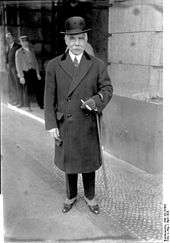
In 1933, the smooth and affable Kahn successfully disarmed antagonism against members of the banking community during four days of testimony before the United States Senate's Pecora Commission hearings into the Wall Street Crash of 1929. The Senate's lead counsel Ferdinand Pecora wrote on page 293 in his 1939 memoir Wall Street Under Oath about Otto Kahn: "No suaver, more fluent, and more diplomatic advocate could be conceived. If anyone could succeed in presenting the customs and functions of the private bankers in a favorable and prepossessing light, it was he."[5]
Kahn was a trustee of the Massachusetts Institute of Technology and of Rutgers College. He was a director in numerous corporations, including the Equitable Trust Co. of New York and the Union Pacific Railroad.[2]
During the last years of Kahn's life he became increasingly frail and suffered from arteriosclerosis, high blood pressure and attacks of angina pectoris. On March 29, 1934, following lunch in the private dining room of Kuhn, Loeb & Co., Kahn suffered a massive heart attack and died, aged 67.[6] Funeral services were held in the music room of his Long Island estate, followed by a burial in nearby St. John's Memorial Cemetery.[7]
Patron of the arts
An extremely wealthy financier, Kahn was president and chairman of the board of directors of the Metropolitan Opera, vice-president of the New York Philharmonic and treasurer for the American Federation of Arts. He supported many artists such as Hart Crane, George Gershwin and Arturo Toscanini. He was also smitten with Hollywood, to which Kuhn Loeb provided much commercial support and Kahn, personal support. In her second full-length film, Be Yourself, Fanny Brice sang a song that mentioned Kahn: "Is something the matter with Otto Kahn, or is something wrong with me? I wrote a note and told him what a star I would make. He sent it back and marked it 'Opened by mistake.'"
He was parodied as Roscoe W. Chandler in the stage and film versions of the Marx Brothers's Animal Crackers.
Kahn was chairman of the New York committee of the Shakespeare Tercentenary (1916).[2] He was elected to honorary membership in Phi Mu Alpha Sinfonia music fraternity by the Fraternity's Alpha Chapter at the New England Conservatory in 1917 and of the French Theatre of New York and a founder and later treasurer of the New Theatre Company.[2]
Otto's son, Roger Wolfe Kahn, was a popular jazz musician and band leader of the late 1920s and early 1930s. Kahn's daughter, Margaret "Nin" Dorothy Wolff Kahn, married John Barry Ryan II and was a New York society doyenne and benefactor of the Metropolitan Opera.
It is sometimes claimed that one of Otto Kahn's most enduring achievements is his uncanny lookalike persona that purportedly became the iconic symbol for the Monopoly board game.[8][9][10][11]
Builder
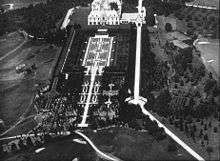
As was typical for men of his stature of the era, Kahn maintained both a New York City residence and a home in the country. Kahn's original country home, a gift from his father-in-law, was in Morristown, New Jersey.[12] Although a resident there for a number of years and a business associate of many of his neighbors, antisemitism was still prevalent and Kahn was never accepted by Morristown society. Social rejection led him to move to Long Island and his New Jersey estate ultimately became home to Honeywell.[13][14]
By 1919, Kahn had assembled a 443-acre (179 ha) estate on Long Island, and had Oheka Castle (from Otto Hermann Kahn) built as its centerpiece. At 109,000 square feet (10,100 m2), the 127 room[15] structure was designed as the second largest private residence in the United States (after George Vanderbilt's 175,000-square-foot (16,300 m2) Biltmore Estate in Asheville, North Carolina) by Delano & Aldrich of New York City; its landscaping was designed by Olmsted Brothers, sons of Frederick Law Olmsted of Brookline, Massachusetts. The property featured a golf course, a working farm, a private airstrip, and numerous outbuildings.
Following Kahn's death in 1934, the property was sold to the City of New York for use as a retreat for sanitation workers and then later a government training school for merchant marine radio operators. In the late 1940s, an upscale housing development was constructed there and in 1948, the Eastern Military Academy (EMA) purchased the mansion and 23 acres (9.3 ha) around it. (One of the former EMA cadets has written his memories going to school there.)[16] By the time the school went bankrupt thirty years later, the gardens had been bulldozed, its rooms subdivided and the paneled walls painted over. Following the departure of EMA, vandals repeatedly set fire to the building, but because Kahn had insisted on constructing a concrete, brick and steel structure, the house survived. In 1984 a local developer, Gary Melius, purchased the estate for $1.5 million and began the largest private renovation project ever attempted in the United States.[17] Today, Oheka is used as a catering facility, hotel and conference center.
Following his acquisition in 1913 of the property at 1 East 91st Street in New York City from Andrew Carnegie, Kahn commissioned J. Armstrong Stenhouse and C. P. H. Gilbert to design his Carnegie Hill mansion. The home, an 80-room Italian Renaissance-palazzo style mansion, was modeled after the Cancelleria in Rome. Completed in 1918, it served as Kahn's New York City residence until his death. Shortly thereafter, the house was sold to the Convent of the Sacred Heart, an independent Catholic girls school. In 1974 the house was designated a landmark by the New York City Landmarks Preservation Commission.[18]
In Palm Beach, Florida, Kahn built a summer home on Sunset Avenue, naming it "Oheka". When this house proved too small, he built another "Oheka" at 691 North County Road. Following his death, this house was used by the Graham-Eckes School.[19] In the 2000s, it was acquired by businessman Robert Cohen and returned to private use.[20]
Boat owner
In 1927, Kahn commissioned German boat builder Lürssen to build a high-speed motor yacht for use on the river Rhine and in the North Sea. Designed using a classical round bottomed hull, she had a composite wooden plank over alloy metal frame structure. But innovative hull design meant that her hull flattened towards the rear third, and with her three 500 hp Maybach engines positioned forward in her 22.5 metres (74 ft) hull, the resultant counterbalance and high power gave her a 34 knot top speed, the highest in her class for the day. Oheka II came to the notice of the German Navy, resulting in their development of the Schnellboot high speed torpedo craft within the restrictions of the Treaty of Versailles.
Family
Parents
- Bernhard Kahn (May 23, 1827, Stebbach, Germany – March 8, 1905, Heidelberg, Germany)
- A son of Michael Kahn and Franziska Baer, a German-Jewish industrialist and banker who participated in the 1848 Revolt, and was condemned to death. He escaped to the United States, was naturalized an American citizen, and then returned to Germany ten years later to court and on October 17, 1860, marry Emma Stephanie Eberstadt, whom he married on the condition that he not return to the United States.
- Emma Stephanie Eberstadt (October 29, 1840, Worms – June 26, 1906, Berlin)[21]
- First daughter and third child of the Worms merchant and Burgermeister Ferdinand Eberstadt and his wife, Sara Zelie Seligmann.
The couple had eight children and Otto was the fifth child and third son. His siblings were:
- Franz Michael Kahn (August 2, 1861, Mannheim, Germany – December 6, 1904, Strasbourg, France [in 1904: Straßburg, Germany]), German jurist
- Clara Maria (June 29, 1863, Mannheim, Germany – January 29, 1922, Berlin, Germany), married to Paul Jonas, German lawyer and AEG board member
- Robert Kahn (July 21, 1865, Mannheim, Germany – May 29, 1951, Biddenden, Great Britain), German composer
- Elisabeth Franziska, called "Lili" (August 19, 1869, Mannheim, Germany – 1940? [missing after April 17, 1940, Ostend, Belgium]), married to Felix Deutsch, German industrialist, co-founder and director of AEG
- Paul Friedrich Kahn (February 1, 1870, Mannheim, Germany – February 12, 1947, Athens, Greece), private secretary to Gerhart Hauptmann, later AEG director in Athens
- Felix Paul Kahn (January 25, 1873, Mannheim, Germany – July 25, 1950, New York City), banker at Kuhn, Loeb & Co., director of the Paramount Pictures Corporation, noted violin collector
- Hedwig (June 17, 1876, Mannheim, Germany – after 1950, London, Great Britain [?]), married names Meier and Pollack
Wife
- Adelaide Wolff (June 10, 1875, New York City[22] – May 15, 1949, London)[23] Married January 8, 1896 [24]
Children
- Maud (Momo) Emily Wolff Kahn (July 23, 1897, Morristown, New Jersey – October 24, 1960, New York City)
- Married June 15, 1920, Cold Spring Harbor, New York, John Charles Oakes Marriott (later Major-General Sir John Marriott), (1895, Stowmarket, Great Britain – September 11, 1978, Great Britain), one child
- Margaret (Nin) Dorothy Wolff Kahn (July 4, 1901, Morristown, New Jersey – January 26, 1995, New York City)
- Married February 9, 1928, New York City, John Barry Ryan Jr. (1901, USA – January 21, 1966, Cold Spring Harbor, New York), two children, John Barry Ryan III and Virginia Fortune Ryan (Countess of Airlie)
- Gilbert Wolff Kahn (July 18, 1903, Morristown, New Jersey – December 15, 1975, Old Brookville, Long Island)
- Married November 19, 1924, New York City, Anne Elizabeth Whelan, one child, Claire Ann, divorced
- Married February 1, 1933, New York City, Sara Jane Heliker, a Broadway dancer (1912, Milwaukee, Wisconsin – 1988, Largo, Florida) one child, Gilbert W. Jr (~1940 – November 2008),[25] divorced
- Married June 30, 1938, New York City, Polly Stover, a fashion model (died 2006)
- During WWII, Gilbert was a commander in the flag unit of Commander Aircraft South Pacific and won a letter of commendation from the chief of the Bureau of Naval Aeronautics for distinguished service in the South Pacific where his unit was assigned. He was awarded the French Legion of Honor.[26][27]
- Roger Wolff Kahn, ( October 19, 1907, Morristown, New Jersey – July 12, 1962, New York City)
- Married January 26, 1931, Cold Spring Harbor, New York, Hannah Williams, a Broadway singer and dancer, divorced 1933
- Married April 7, 1933, Hempstead, Long Island, Edith May Nelson, a politician's daughter (October 13, 1910, Waterville, Maine – September 1994, Glen Cove, Nassau County, New York), two children
Burial place
Kahn was buried in the St. John's Memorial Cemetery in Laurel Hollow, Cold Spring Harbor, New York.[28]
Selected books and speeches by Kahn
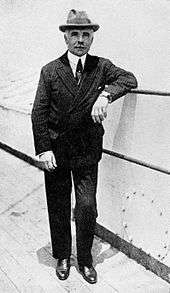
- Of Many Things; Being Reflections and Impressions on International Affairs, Domestic Topics and the Arts (a compilation of speeches and writings, 1926)
- The Value of Art to the People (1924)
- The Myth of American Imperialism (1924)
- Reflections of a Financier – A Study of Economic and Other Problems (1921)
- Two Years of Faulty Taxation (1920)
- Our Economic and Other Problems: A Financier's Point of View (1920)
- Suggestions Concerning the Railroad Problem (1919)
- Let Us Reason Together (1919)
- Taxation: A Letter (1918)
- Right Above Race (1918)
- Poison Growth of Prussianism (1918)
- The Menace of Paternalism (1918)
- When the Tide Turned (1918)
- Frenzied Liberty (1918)
- The Common Cause: Britain's Part in the Great War (1918)
- Some Comments on War Taxation (1918)
- The War and Business (1917)
- Prussianized Germany. Americans of Foreign Descent and America's Cause (1917)
- Art and the People (1916)
Quotations
"The deadliest foe of democracy is not autocracy but liberty frenzied. Liberty is not foolproof. For its beneficent working it demands self-restraint, a sane and clear recognition of the practical and attainable, and of the fact that there are laws of nature which are beyond our power to change." (from a speech given at the University of Wisconsin–Madison) [29]
On business: "It has long been our policy and our effort to get our clients, not by chasing after them, not by praising our own wares, but by an attempt to establish a reputation ... We have no show window; our only attractiveness is our good name and our reputation for sound advice and integrity ... If we do not live up to what they [our clients] believe is our capacity, and to what they believe is the value of our sponsorship, of our trade-mark, they will quit us. And we have no means to prevent them."
See also
References
Notes
- ↑ Biographical Dictionary of American Business Leaders, vol. 2, by John N. Ingham
- 1 2 3 4 5
 Chisholm, Hugh, ed. (1922). "Kahn, Otto Hermann". Encyclopædia Britannica (12th ed.). London & New York.
Chisholm, Hugh, ed. (1922). "Kahn, Otto Hermann". Encyclopædia Britannica (12th ed.). London & New York. - 1 2 3 4 5
 Homans, James E., ed. (1918). "Kahn, Otto Hermann". The Cyclopædia of American Biography. New York: The Press Association Compilers, Inc.
Homans, James E., ed. (1918). "Kahn, Otto Hermann". The Cyclopædia of American Biography. New York: The Press Association Compilers, Inc. - ↑ "Otto H. Kahn Now American Citizen; Banker Passes Final Examination Before Judge At Morristown, N. J. Has Lived Here 23 Year Determined To Change Alleglance Prior To The War, But Postponed Application". The New York Times. March 29, 1917. Retrieved 2010-10-01.
Otto H. Kahn of the banking firm of Kuhn, Loeb Co. became an American citizen yesterday, having passed his final examination in the morning before Judge ...
- ↑ Otto Kahn: Art, Money, & Modern Time, By Theresa Mary Collins, page 293, Published by UNC Press, 2002
- ↑ "Otto Kahn, 67, Dies Of Heart Attack In Bank's Offices. Banker And Arts Patron, Long Ill, Stricken At Luncheon With Kuhn, Loeb Partners. Wall Street Is Shocked Morgan And Lamont Hurry To Office. Leaders Pay Tribute. Music World Mourns". The New York Times. March 30, 1934. Retrieved 2010-01-16.
Otto H. Kahn, philanthropist and patron of the arts, died shortly after 1:45 P.M. yesterday at the offices of Kuhn, Loeb Co., 52 William Street, the private banking firm in which he was senior partner. His death shocked his associates and members of the financial community by its suddenness.
- ↑ "Otto H. Kahn is Buried on Long Island. Simple Services Are Held at Financier's Country Home at Cold Spring Harbor. Only Family, Close Friends and Associates Attend". The New York Times. April 3, 1934. Retrieved 2010-10-01.
- ↑ Otto Kahn's Palm Beach by Augustus Mayhew, New York Social Diary, February 27, 2015
- ↑ "History of The Oheka Castle". oheka.com.
- ↑ "Remembering Otto Hermann Kahn, One of Long Island’s Stellar Citizens©". behindeverygreatfortune.com.
- ↑ "Big Old Houses – "The King of New York"". New York Social Diary.
- ↑ "Kahn Sells 'Cedar Court'; New Jersey Country Estate to Become Diabetes Sanitarium"
- ↑ "Honeywell History". hon-area.org.
- ↑ Bleyer, Bill. "His Home Was a Castle: Stung by anti-Semitism, Otto Kahn moves to LI and constructs 127 rooms", Newsday. Accessed May 12, 2008. "Otto Hermann Kahn was a rising figure in the banking industry and a generous patron of the arts. But to his wealthy neighbors in Morristown, N.J., in the early 1900s, Kahn had an overriding fault: He was Jewish."
- ↑ "History". Oheka Castle Hotel and Estate. Retrieved 11 August 2013.
- ↑ Hall, Roger. "Dream World": Songs, Poems and Stories, PineTree Press, 2007
- ↑ "Next Role for Otto Kahn's 126-Room Mansion", The New York Times, 4 January 1998, page RE7
- ↑ "2 Mansions on 91st Dubbed Landmarks Of Beaux Arts Style". The New York Times. January 20, 1972. Retrieved 2008-04-06.
Two Beaux-Arts-style mansions on 91st Street near Fifth Avenue were designated city landmarks yesterday after a four-year dispute with the buildings' owner, the Convent of the Sacred Heart.
- ↑ Kobler, John. Otto the Magnificent. New York: Macmillan Publishing Company, 1988; 117
- ↑ "Social Diary 2/7/06 - Summing up (in full) our trip to Palm Beach". newyorksocialdiary.com.
- ↑ Emma Kahn
- ↑ "Passport application".
- ↑ "Mrs. O. H. Kahn Dies; Widow Of Banker". The New York Times. May 16, 1949.
- ↑ The Many Lives of Otto Kahn by Mary Jane Phillips-Matz; Macmillan (1963) p. 19; Retrieved April 30, 2017
- ↑ Deaths – Kahn, Gilbert S
- ↑ The Princeton Alumni Weekly, 26 January 1976, page 14, - Memorials - Gilbert Wolff Kahn ’26
- ↑ "iGavel Auctions: THREE PIECES OF JEWELRY R2MNH, R2MNG, R2MNJ, R2MNP, R2MNT, R2MNR". igavelauctions.com.
- ↑ "Otto Kahn (1867–1934)". Find a Grave. January 1, 2001.
- ↑ "Liberty Quotations Collected by GIGA (Page 3)". giga-usa.com.
Further reading
- Collins, Theresa M. Otto Kahn: Art, Money & Modern Time. The University of North Carolina Press, 2002
- Collins, Theresa M. Introducing Otto H. Kahn
- King, Robert B. Raising a Fallen Treasure: The Otto H. Kahn Home, Huntington, Long Island. The Mad Printers of Mattituck, 1985
- Kobler, John. Otto the Magnificent: The Life of Otto Kahn. Charles Scribner's Sons, 1988
- Matz, Mary Jane. The Many Lives of Otto Kahn. Macmillan Publishing Company, 1963
External links
| Wikimedia Commons has media related to Otto H. Kahn. |
Otto Kahn
- Works by Otto Hermann Kahn at Project Gutenberg
- Works by or about Otto Hermann Kahn at Internet Archive
- Otto Hermann Kahn from the Library of Congress at Flickr Commons
- Otto Kahn: "High Finance" (1916)
- "Death At No. 52". Time. 1934-04-09. Retrieved 2008-08-09.
- On the Cover of Time Mag (Nov. 2, 1925), and "Mr. Kahn & Mr. Gatti" in same issue
- Otto H. Kahn Papers at Princeton University includes a short biography and a photograph of the financier.
- St. John's Memorial Cemetery, Laurel Hollow, Cold Spring Harbor, New York
Long Island estate
New York City home
- Otto and Addie Kahn Home, New York City
- Otto and Addie Kahn Home, New York City
- Convent of the Sacred Heart's website
Sister projects
-
 "Kahn, Otto Hermann". The Cyclopædia of American Biography. 1918.
"Kahn, Otto Hermann". The Cyclopædia of American Biography. 1918.
